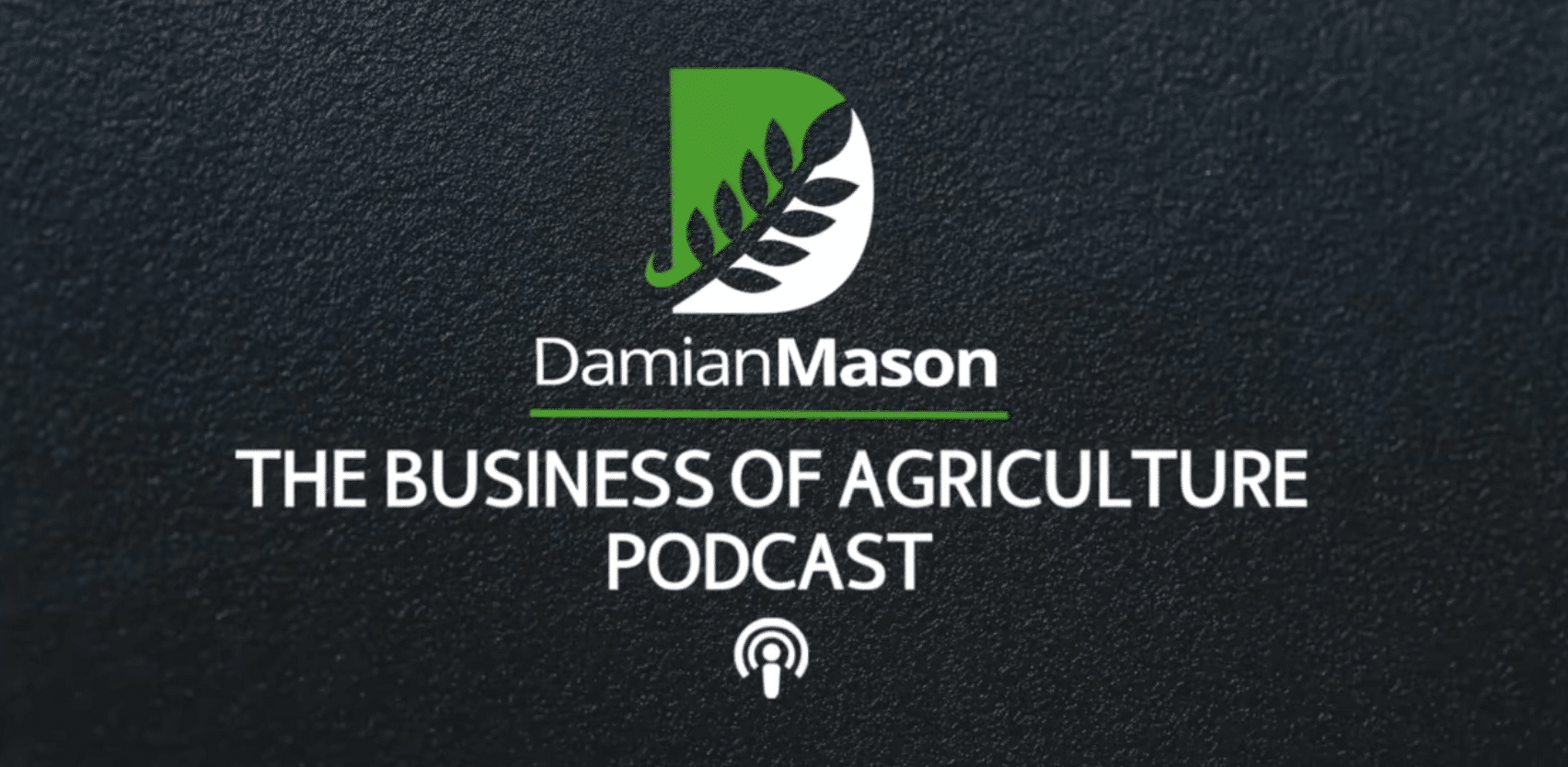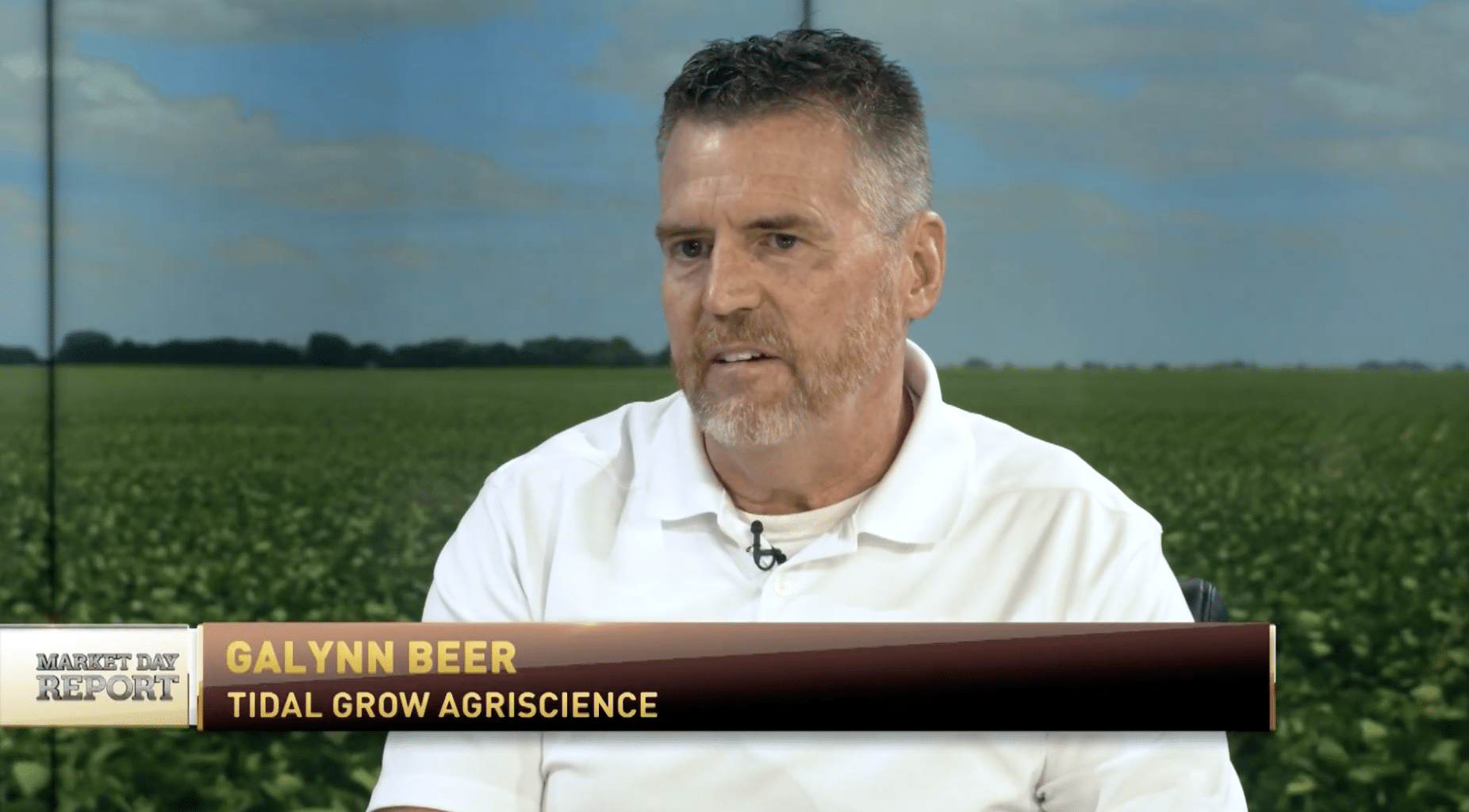Smarter fall prep means healthier soil, easier planting, and boosted ROI.
Post-harvest is a crucial time to start managing residue and feeding the microbial life that drives nutrient cycling. As soil temperatures begin to cool, biological activity slows, but it doesn’t stop. This period offers a valuable chance to speed up decomposition, build organic matter, increase biological nutrient availability, and stabilize soil structure ahead of winter.
For crops like corn, wheat, canola, and soybeans, the carbon-to-nitrogen (C:N) ratio of residue influences how quickly it breaks down. High C:N residue takes longer to decompose, especially without biological support. In these conditions, nutrients like nitrogen and phosphorus can become tied up, affecting seedbed quality and spring readiness. By applying soil-building inputs, you can help activate microbial life to support residue breakdown and maintain long-term soil health.
We formulated Tidal Grow® Oceanic® and Oceanic® Organic with this role in mind, among many other benefits, when applied throughout the season. These cold-processed seafood hydrolysate fertilizers deliver bioavailable amino acids and activate biological processes in the detritusphere, the zone around decomposing material, helping convert crop residue into stable organic matter that supports future soil function.
This article outlines five research-backed reasons to implement a post-harvest residue management program. It also explores how residue composition influences nutrient cycling, emphasizes the importance of microbial feeding, and explains how fall applications can support both agronomic and financial returns. These practical strategies can help you improve soil health and build a more profitable operation.
5 Benefits of Residue Management for Healthier Spring Fields
Applying microbial food sources in the fall helps improve soil performance in multiple ways. It enhances nutrient cycling, supports soil conservation goals, improves planting conditions, and could qualify you for carbon credits or conservation incentive programs. When applied properly, residue management inputs support microbial life and reduce nutrient tie-up at a critical time in the crop cycle.
1. Prepare Fields Early and Minimize Spring Workload
Untreated residue can slow down planting the following spring and may require additional tillage. Starting residue breakdown in the fall allows for quicker field access, less compaction risk, and more efficient planting. These fields often warm up faster and dry out sooner, giving your crops a better start. With this approach, you could be ready to plant multiple days in advance. By minimizing spring delays and creating a more favorable seedbed, fall microbial support offers logistical and financial advantages. These efficiencies can make a significant difference in tight planting windows, especially when weather variability limits early access to fields. Improving soil temperature and reducing residue mass also lessens the strain on machinery. And as a result, you can make better use of favorable weather.
2. Enhance Nutrient Cycling and Improve Input Efficiency
High-residue conditions can lock up key nutrients like nitrogen and phosphorus from the current year’s crop. Crop residue left on the surface can conserve moisture, support microbial decomposition, and build organic matter, which helps release tied-up nutrients back into the soil system. This helps improve crop vigor, reduce early-season deficiencies, and optimize fertilizer applications the following year. Over time, stronger nutrient cycling capitalizes on residual nutrient inputs and can help lower overall production costs. This transition supports long-term soil performance by maintaining more natural nutrient pathways and protecting microbial balance. Enhanced microbial activity also contributes to better nutrient synchronization, ensuring that crops receive nutrients when they are most needed.
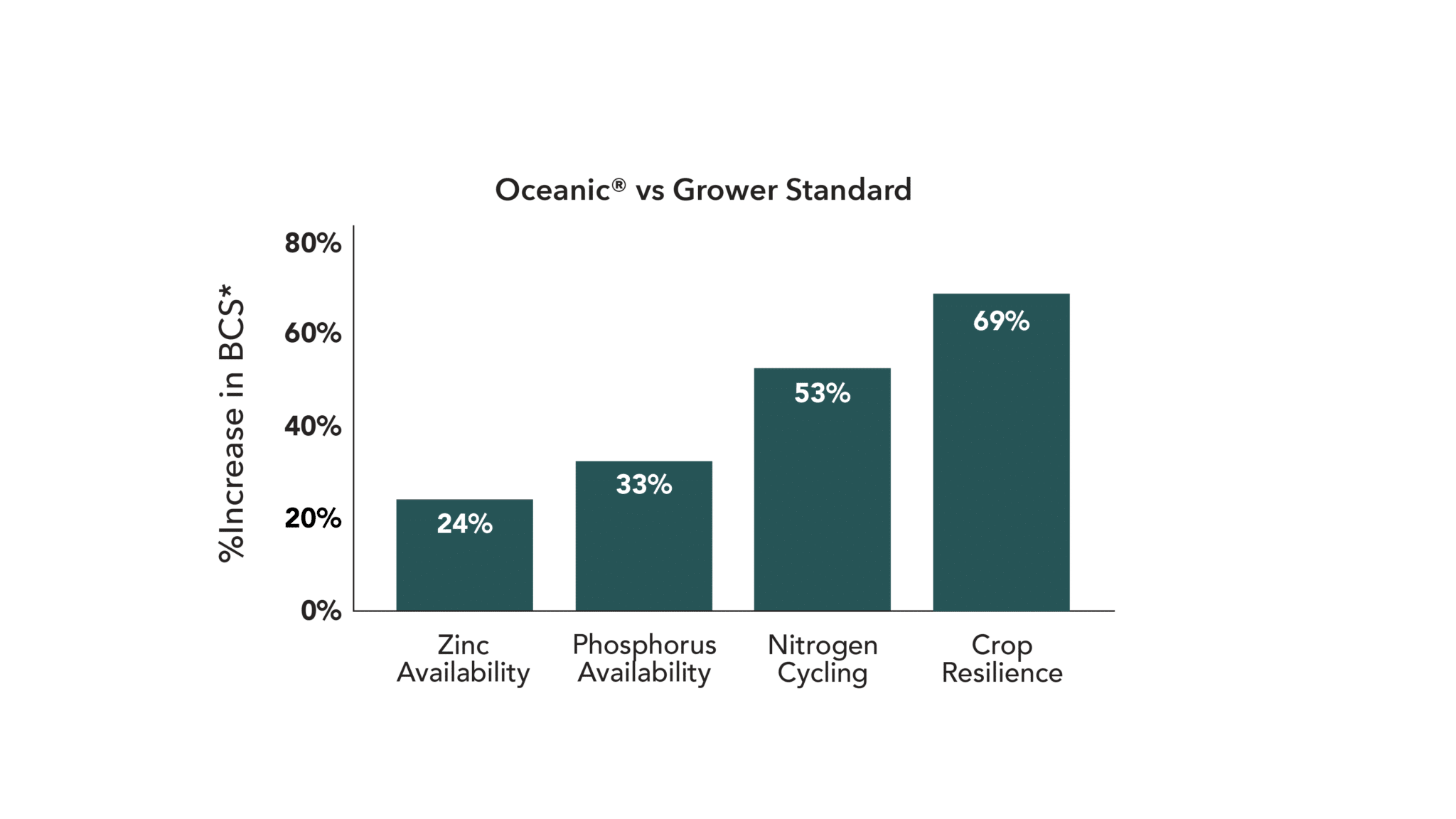
Through facilitating a robust and highly functional soil microbiome, application of Oceanic fosters microbial populations involved in liberating nutrients from crop residue.
3. Improve Soil Quality and Build Organic Matter
Tidal Grow® Oceanic® provides steady nutrition to microbial communities, even as temperatures decline. The combination of amino acids, fish oils, trace minerals, and amino sugars supports both fungi and bacteria that drive soil aggregation and nutrient cycling. These biological processes contribute to disease suppression and overall system resilience. Active soil biology creates a more balanced ecosystem. With robust microbial networks in place, your fields are better equipped to handle abiotic stressors such as drought, nutrient variability, and temperature shifts. These improvements also promote organic matter formation and long-term soil function. As microbial communities expand, they help bind soil particles and support lasting productivity.
4. Save on Fuel with Reduced-Till and No-Till Systems
Fall microbial activity helps reduce the need for aggressive tillage in spring. Feeding microbial life supports soil structure, helps optimize moisture from winter precipitation, and reduces erosion risk. These regenerative benefits can help maintain long-term soil performance. Supporting soil biology is a proactive step for growers balancing productivity and stewardship. It allows reduced-till systems to function effectively without sacrificing planting efficiency. Microbial support in fall builds resilience that carries into the next growing season. These outcomes help you maintain consistent yields and preserve valuable topsoil.
5. Qualify for Carbon Credits and Conservation Incentives
Practices that build soil organic matter, reduce tillage, improve nutrient cycling, and support microbial communities may qualify for conservation payments or carbon credits. These initiatives reward practices that promote soil health and reduce environmental impact. Fall soil inputs that increase microbial activity and reduce nitrogen loss when applied under the right conditions align well with climate-smart principles. Participation in these programs may offer market advantages as sustainability metrics gain relevance in production systems. This alignment also positions your operation to engage with evolving market opportunities and policy frameworks.
Understanding the Role of High C:N Ratio Residue in Nutrient Cycling
High-residue crops create biological and operational challenges that can persist into spring. Surface residue affects soil temperature, delays nutrient availability, limits microbial activity in the root zone, and complicates early equipment passes. These conditions can further hinder seedbed prep, delay planting, and impact fertilizer program performance. Crops like wheat, corn, canola, and soybeans all leave behind residue with different C:N ratios. Residue type, volume, and decomposition rate can significantly affect how the soil is prepared for spring planting. Wheat is about 91:1, corn is 73:1, canola is similar at 72:1, and soybeans are more easily decomposed at 53:1. The higher the ratio, the more carbon-heavy and nitrogen-deficient the material, making it harder for microbes to process without support.
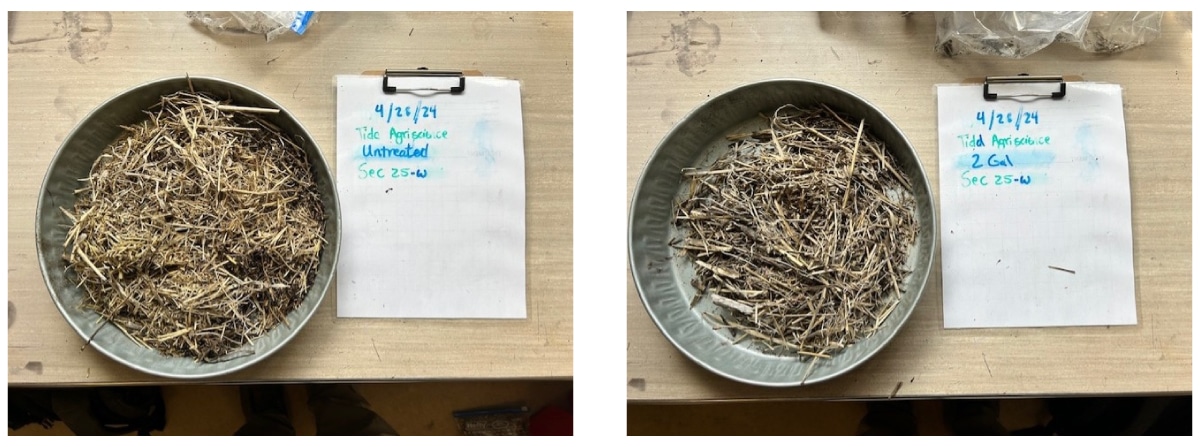
Applying 2 gal/A of Oceanic® on wheat residue around two weeks prior delivered 35% crop residue reduction and decrease in biomass. Photo taken spring 2024 about six months after the application in Ward County, ND (USA).
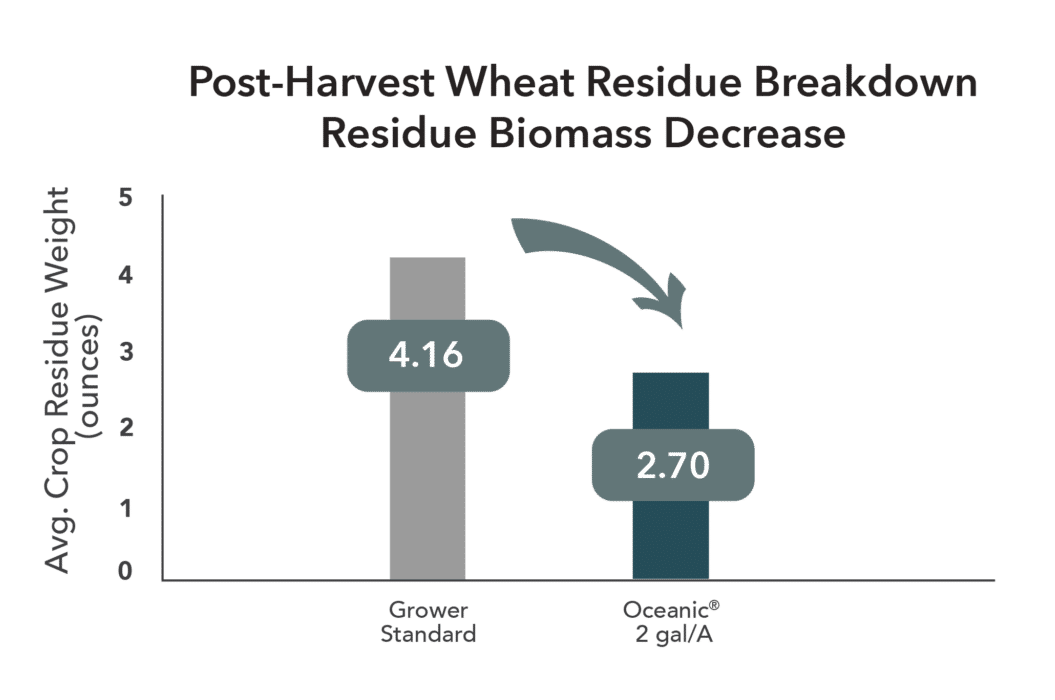
When high C:N residue is left untreated, decomposition slows. Microbial communities become nitrogen-limited, delaying nutrient release and leading to cooler, less uniform soils in spring. Fall applications help reverse this trend by feeding microbes, improving soil structure, and enhancing planting conditions. Tidal Grow® Oceanic® and Oceanic® Organic are well suited for these scenarios. Their seafood-based nutrients supply amino-rich compounds that help rebalance C:N ratios and activate the microbial processes necessary for effective residue conversion.
How and Why Post-Harvest Soil Inputs Work
The detritusphere is where microbial life transforms crop material into stable organic matter and nutrients. Active microbes in this area also support porosity, root development, biological diversity, and ongoing nutrient cycling. Tidal Grow® Oceanic® fuels this biology with compounds that energize the microbial populations that support soil aggregation, mineralization, and disease suppression. Keeping these microbes active helps sustain soil structure and maintain microbial cycling as temperatures drop.
Over time, this microbial activity improves water retention, aggregate stability, and system resilience. Though activity slows in winter, applying Tidal Grow® Oceanic® before freeze-up keeps microbes functioning long enough to drive meaningful residue conversion. This approach also reduces mechanical disturbance and prepares your fields for a better spring.
Fall Soil Health Support with Tidal Grow® Oceanic®
Fall applications of Tidal Grow® Oceanic® bring a range of clear benefits, including increased yield and ROI up to 4:1. By feeding soil biology and unlocking nutrients from residue, they reduce the need for intensive spring tillage and help create a more workable, consistent seedbed. This leads to better seed-to-soil contact, reduced compaction, and stronger early crop development.
The seafood-based formula provides reliable microbial nutrition that remains effective even as soil temperatures drop. Key compounds like omega-3 fatty acids support microbial activity that improves soil structure, increases porosity, enhances moisture retention, and contributes to more uniform soil texture across the field. With a 2-1-0 NPK profile, each application supports nitrogen availability while helping release micronutrients held in crop residue. This is especially valuable in high C:N systems where early nutrient stress is a concern.
The recommended rate is 1 to 2 gallons per acre applied after harvest and before the first local freeze, depending on crop type and field conditions. These rates are intended to activate biology at the residue-soil boundary and prepare fields for spring. To get the most from your application, consider working with an agronomist or crop consultant to customize your post-harvest plan. Matching your input strategy with residue load, equipment availability, and soil condition ensures consistent value across your system.
Best Practices for Applying Tidal Grow® Oceanic® in Post-Harvest Residue Management Programs
- Timing is important for fall applications. Aim to apply before the first local freeze, when soil conditions are still favorable and microbial activity can begin converting residue efficiently. Applying shortly after harvest allows biology to respond before winter dormancy sets in.
- Tidal Grow® Oceanic® fit easily into most fall equipment setups. Standard ground rigs work well, and simple practices like light agitation and routine equipment checks help maintain product consistency. If you are combining them with other inputs, a quick jar test can confirm compatibility and protect microbial integrity.
- Even coverage is also essential. If incorporation is planned, keep it shallow to avoid disturbing soil structure or damaging microbial zones. In no-till systems, surface application is effective for activating the detritusphere and starting the decomposition process.
- Avoid applications when soils are frozen or saturated. Proper placement and thoughtful timing allow the soil’s biological engine to engage, setting up better spring conditions and improving the impact of your fall program.
Proven ROI and Yield Opportunities from Tidal Grow® Oceanic® Applications
Results show that applying Tidal Grow® Oceanic® post-harvest leads to measurable returns. In high-residue systems, the product improves nutrient cycling, increases yield, and strengthens soil aggregation. These outcomes help minimize input waste and contribute to more consistent, profitable crop performance. In wheat residue trials before canola (North Dakota), Tidal Grow® Oceanic® applied at 2 gallons per acre delivered a 5.5 bushel per acre yield increase. This result represented a 3:1 return on investment and cut residue mass by 54 percent, making fields easier to plant with less tillage. These gains highlight its value in breaking down residue and restoring balance to high carbon-to-nitrogen zones.
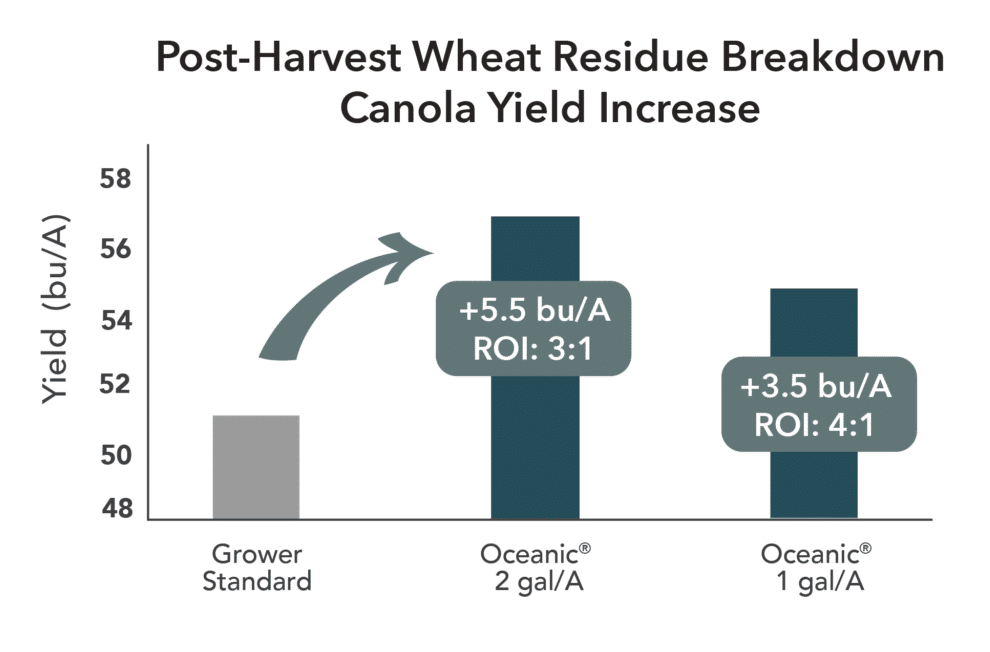
As soils cool, Tidal Grow® Oceanic® continues to fuel microbial activity. This biological carryover builds organic matter, improves nutrient cycling, preserves soil structure, and better prepares your field for winter. The result is faster nutrient turnover, fewer spring delays, and stronger early-season growth. These performance benefits also support long-term soil conservation and align with regenerative goals. By feeding soil microbes in the fall, you set up a system that supports productivity and sustainability. For those managing heavy residue, it’s a smart way to strengthen ROI, unlock carbon credit potential, and lay the foundation for lasting soil health.
Conclusion: Build Soil Health and Structure with Smarter Fall Applications
Post-harvest is a timely opportunity to restore soil balance, especially in high-residue fields. Tidal Grow® Oceanic® supports the biology needed to convert residue, enhance soil structure, reduce field pressure, and improve planting conditions. Starting this biological support before winter gives microbial communities the head start they need. Fall applications also represent a strategic opportunity for you to adapt to evolving industry demands. As more markets and policies begin rewarding soil stewardship with carbon credits, practices that prioritize soil biology will have added value. Aligning residue management with both agronomic and sustainability goals makes fall inputs a forward-thinking investment.
Adding a fall residue management step is a chance to influence the entire system’s efficiency and return. Supporting microbial life when it’s still active helps you get the most value from every acre. It’s one of the simplest ways to improve soil function while addressing both short- and long-term performance goals.
If you’re focused on reducing spring workload, boosting ROI, and building long-term resilience, fall applications offer a reliable edge. Tidal Grow® Oceanic® and Oceanic® Organic deliver consistent biological support that helps you prepare for next season with more control and less stress. This investment in post-harvest residue management sets the stage for better plant health, improved performance, and a system built to deliver returns season after season.
Prepare and Protect Your Soil with Tidal Grow® AgriScience
Talk to your Tidal Grow® AgriScience representative about incorporating Tidal Grow® Oceanic® into your fall program. Begin converting residue, supporting microbial life, increasing moisture retention, and strengthening your soil system ahead of spring. Fall is the ideal time to give your fields an early start on a healthier, more productive season.
Citations
Brooker, A. (2024, September 30). Fall residue “DOs.” Beck’s Hybrids. https://www.beckshybrids.com/resources/croptalk-newsletter/fall-residue-dos
Cherlinka, V. (2025, February 19). Crop Residue Management To Improve Soil Fertility. EOS Data Analytics. https://eos.com/blog/crop-residue-management/
Farm Progress. (2023, October 18). Effectively managing postharvest residue. https://www.farmprogress.com/crops/effectively-managing-postharvest-residue
Fernandez, F. (2022, October 4). Fall nitrogen fertilizer application: The what, where, when and how. University of Minnesota Extension. https://blog-crop-news.extension.umn.edu/2022/10/fall-nitrogen-fertilizer-application.html
Nickel, R. (2015, November 9). Crop Residue as a Soil Saving Strategy. Successful Farming. https://www.agriculture.com/crops/tillage/crop-residue-as-a-soil-saving-strategy_187-ar51056





